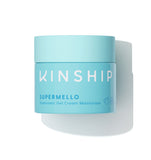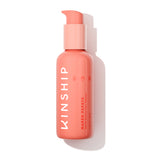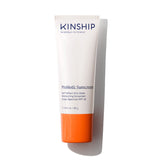Salicylic acid is a beta hydroxy acid (BHA) widely used in skincare for its ability to penetrate the skin and exfoliate inside the pores. In fact, it is found in products like cleansers, toners, and spot treatments.
This ingredient is particularly effective in treating acne by dissolving excess oil and dead skin cells, which can clog pores and cause breakouts.
Salicylic acid also helps reduce inflammation and redness, making it suitable for various skin types — especially acne-prone skin and blemish-prone skin.
You may wonder, "Is salicylic acid good for sensitive skin?" This popular skincare ingredient pairs well with sensitive skin, but it depends on what product you use.
This article will focus on whether it is also beneficial for sensitive skin and how you can integrate it safely and effectively into your skincare routine.

What Is Salicylic Acid?
Salicylic acid is a beta hydroxy acid (BHA) with unique chemical properties that make it highly effective in skincare — particularly when it comes to treating acne and improving skin texture.
Unlike alpha hydroxy acids (AHAs), which are water-soluble, salicylic acid is oil-soluble. This oil solubility allows it to penetrate deep into the skin’s surface, effectively breaking down the sebum and dead skin cells that clog pores and lead to acne.
Once inside the pores, salicylic acid works by gently exfoliating the inner walls, helping to clear out impurities and reduce blockages that cause blackheads, whiteheads, and other forms of acne.
This deep exfoliation also helps to smooth skin texture by removing the outer layer of dead skin cells, which can make the skin appear rough and dull.
On top of that, salicylic acid has anti-bacterial and anti-inflammatory properties, which can help reduce redness and swelling associated with acne. This makes salicylic acid good for sensitive skin.
Recommended Products
Benefits of Salicylic Acid for Sensitive Skin
Salicylic acid offers many benefits for the skin, making it a valuable ingredient in many daily skincare routines when used correctly, even for those with sensitive skin.
- Managing Mild Acne: Salicylic acid is particularly effective in treating mild acne, such as blackheads and whiteheads. By penetrating deep into the pores, it helps dissolve the sebum and dead skin cells that can clog pores, preventing and reducing breakouts.
- Reducing Redness and Inflammation: Salicylic acid possesses anti-inflammatory properties, which can help calm the skin and reduce redness associated with acne and other skin irritations. In short, it can help manage acne without causing excessive irritation.
- Gentle Exfoliation: Unlike physical exfoliants that can be harsh and cause microtears in the skin, salicylic acid provides gentle chemical exfoliation. This helps to remove dead skin cells on the surface, promoting a smoother and brighter complexion without the need for abrasive scrubbing, making it especially beneficial for sensitive skin.
- Maintaining Skin Clarity: Regular use of salicylic acid can help maintain overall skin clarity by keeping pores clean and preventing the build-up of dead skin cells. This contributes to a more even skin tone and texture, helping to minimize the appearance of blemishes and dark spots over time.
- Oil Control: Salicylic acid can help regulate oil production in people with oily skin, reducing the likelihood of clogged pores and breakouts. This makes it a versatile ingredient that can benefit various skin types, including sensitive skin, when used at appropriate concentrations and frequencies.
Challenges of Using Salicylic Acid on Sensitive Skin
Salicylic acid offers many benefits — but it may also have some potential downsides, particularly for users with sensitive skin.
Understanding these risks can help users make informed decisions about how to incorporate it into their skincare routine.
- Irritation and Redness: One of the most common side effects of salicylic acid, especially for sensitive skin, is irritation. This can manifest as redness, stinging, or a burning sensation. Sensitive skin is more prone to these reactions because it has a weaker barrier function, making it less resilient to active ingredients like salicylic acid.
- Dryness and Peeling: Salicylic acid works by exfoliating the skin, which can sometimes lead to excessive dryness and peeling. For those with sensitive skin, this drying effect can be more pronounced, leading to flakiness and discomfort. Overuse or using a concentration that is too high can worsen these symptoms, possibly requiring specialized skincare products for dry skin to remedy.
- Increased Sensitivity: Because salicylic acid is a potent exfoliant, it can make the skin more sensitive to external factors, such as sunlight and harsh weather conditions. This increased sensitivity can lead to a higher risk of sunburn and environmental damage, which can be particularly problematic for sensitive skin types.
- Potential for Over-exfoliation: Sensitive skin may react differently to salicylic acid compared to other skin types, with a higher likelihood of over-exfoliation. This can damage the skin's natural barrier, leading to more significant issues like increased redness, inflammation, and breakouts.
To further minimize these downsides, those with sensitive skin should start with lower concentrations, use the product less frequently, and ensure they follow up with skincare for sensitive skin.
Patch testing and slowly introducing salicylic acid into a routine can also mitigate these risks.

How to Use Salicylic Acid Safely on Sensitive Skin

You may wonder, "Can I use salicylic acid for sensitive skin?"
While salicylic acid for sensitive skin is good, it is vital to carefully consider how to incorporate salicylic acid into a skincare routine for sensitive skin in order to experience the full benefits while minimizing potential irritation.
Below are some tips and recommendations to help integrate it safely.
- Start with Low Concentrations: Begin with products containing a low percentage of salicylic acid, around 0.5% to 1%. This allows your skin to adjust gradually and reduces the risk of adverse reactions. As your skin builds tolerance, you can consider increasing the concentration if needed.
- Choose the Right Product Type: Understanding your skin type is essential for choosing the right product for you. Look for formulations specifically designed for sensitive skin that include additional soothing ingredients.
- Introduce Gradually: Slowly incorporate salicylic acid into your routine, starting with usage once or twice a week. Monitor your skin's response and gradually increase frequency as tolerated. This helps prevent over-exfoliation and allows your skin to adapt comfortably.
- Combine with Soothing Ingredients: Select products that pair salicylic acid with calming and hydrating ingredients such as aloe vera, chamomile, niacinamide, or hyaluronic acid. These components help alleviate potential dryness and irritation, maintaining your skin's moisture barrier.
- Prioritize Moisturization: Always follow up with a gentle, fragrance-free moisturizer after using salicylic acid products. Proper hydration supports skin barrier function and minimizes dryness and peeling associated with exfoliation.
- Perform Patch Tests: Before fully integrating a new salicylic acid product, conduct a patch test by applying a small amount to a discreet area and observing for any adverse reactions over 24 hours. This helps identify potential sensitivities early on.
- Use Sunscreen Daily: Salicylic acid can increase skin's sensitivity to the sun. As such, apply a broad-spectrum sunscreen with at least SPF 30 every morning to protect against UV damage and prevent irritation. Our Self Reflect Zinc Oxide Mineral Sunscreen is formulated to work well with sensitive skin types, helping your skin feel protected and safe under the sun.
- Avoid Combining with Other Exfoliants Initially: Refrain from using other strong active ingredients like retinoids or glycolic acid simultaneously when starting with salicylic acid. This prevents excessive exfoliation and reduces the risk of irritation. Introduce additional actives slowly and monitor skin response.
- Listen to Your Skin: Pay close attention to how your skin reacts. If you notice persistent redness, burning, or discomfort, reduce frequency or discontinue use and consult a dermatologist for personalized advice.
- Consult a Professional: For personalized guidance, especially if you have specific skin concerns or conditions, consult a dermatologist or skincare professional first. They can recommend suitable products and routines tailored to your skin's needs.

What Ingredients Can You Safely Use With Salicylic Acid?
Combining salicylic acid with the right ingredients can improve its effectiveness while minimizing potential irritation. Below are some safe and beneficial combinations.
- Niacinamide: This anti-inflammatory and skin-soothing ingredient pairs well with salicylic acid. Niacinamide helps to reduce redness, regulate oil production, and strengthen the skin barrier, making it ideal for balancing the exfoliating effects of salicylic acid and reducing potential irritation.
- Hyaluronic Acid: A powerful humectant, hyaluronic acid attracts moisture to the skin, counteracting the drying effects that salicylic acid can sometimes cause. This combination, found in our Supermello moisturizer, keeps the skin hydrated and plump, ensuring the exfoliation process does not lead to excessive dryness.
- Aloe Vera: Known for its calming and soothing properties, aloe vera can mitigate any irritation caused by salicylic acid. It helps cool and soothe the skin, making this pairing particularly beneficial for sensitive or reactive skin.
- Ceramides: These essential lipids help to restore and strengthen the skin's natural barrier, preventing moisture loss and reducing irritation. When used with salicylic acid, ceramides help maintain the skin's protective barrier, ensuring that the exfoliating process does not compromise skin health.
- Green Tea Extract: This antioxidant-rich ingredient soothes and protects the skin, reducing inflammation and redness. Combined with salicylic acid, it enhances the treatment of acne while providing additional calming benefits.
These combinations allow for effective exfoliation and acne treatment while ensuring the skin remains balanced, hydrated, and protected.
Always do your research on ingredients to ensure they are safe to use with one another.
For instance, salicylic acid and vitamin C should not be used together since their differing pH levels can cause irritation. However, you may use them separately at different times of the day.
Alternatives to Salicylic Acid for Sensitive Skin
For those who find salicylic acid too harsh, you can consider several alternative ingredients that offer similar benefits but with potentially gentler effects on the skin.
- Lactic Acid: An alpha hydroxy acid (AHA) derived from milk, lactic acid is a milder exfoliant that helps remove dead skin cells, improve texture, and promote a more radiant complexion. It is ideal for sensitive skin as it hydrates while exfoliating, reducing the risk of irritation.
- Azelaic Acid: This dicarboxylic acid is known for its anti-inflammatory and antibacterial properties. It is effective in treating acne, reducing redness, and fading hyperpigmentation, making it an excellent alternative for those with sensitive or rosacea-prone skin. Azelaic acid is less likely to cause dryness or irritation compared to salicylic acid.
- Mandelic Acid: Another AHA, mandelic acid has larger molecules, which means it penetrates the skin more slowly, reducing the likelihood of irritation. It is gentle enough for sensitive skin and effective in exfoliating and treating mild acne.
These alternatives provide effective solutions for exfoliation and acne treatment while being more suited to sensitive skin types.
Frequently Asked Questions (FAQs)
Below are a few frequently asked questions on using salicylic acid on sensitive skin.
When Should You Not Use Salicylic Acid?
You should not use salicylic acid if you are diabetic or have poor blood circulation. It also should not be used on warts, moles, or birthmarks.
Is Salicylic Acid OK to Use Everyday?
Yes, it is okay to use salicylic acid every day. However, you should start by applying it in moderation and working up from there to help your skin get used to it.
What Not to Mix With Salicylic Acid?
You should not mix retinol with salicylic acid because their strong exfoliating and cell turnover effects can lead to excessive skin irritation, dryness, and peeling. As such, it is best to use them separately to avoid over-exfoliating and damaging the skin barrier.
Key Takeaways on Is Salicylic Acid Good for Sensitive Skin?
Salicylic acid can be beneficial for sensitive skin when used correctly, offering effective exfoliation and acne treatment.
However, its potential to cause irritation, redness, and dryness means it must be introduced gradually and with care. This includes starting with lower concentrations, opting for suitable product types like cleansers, and combining them with soothing ingredients.
For those with extremely sensitive skin or who experience adverse reactions, alternative ingredients like lactic acid or azelaic acid might be safer options.
If you are unsure how to integrate salicylic acid or if you should use it at all, consult a dermatologist.



